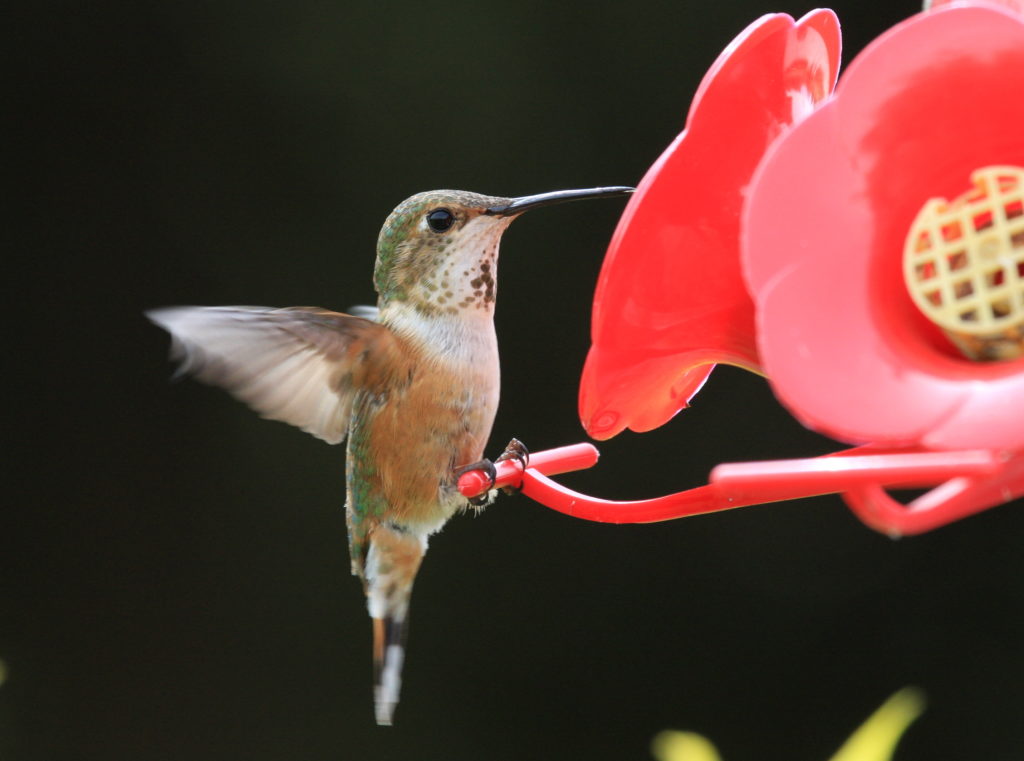Support Us
Since 1979 more than 140,000 animals have been treated by Wildlife Rescue.
Thanks to the support of individuals like you, Wildlife Rescue can provide a lifeline for animals in distress.
If you decide to offer a hummingbird feeder, it’s essential for the birds’ safety to maintain it following the recommended guidelines all year round.

Hummingbirds have the highest metabolism of any warm-blooded animal. A high metabolism calls for high energy fuel. It’s no surprise these little birds love sugar! A simple mixture of refined, white table sugar dissolved in boiled water is sufficient for your hummingbird feeder.
Why pure white sugar?
You must ensure the sugar is pure white – a sign that the molasses has been removed. Molasses is high in iron and can be toxic to hummingbirds. Never use honey, brown sugar, icing sugar, juice, or artificial sweetener. Here’s why:
Sugar to water ratio guidance
The standard sugar to water ratio is 1:4. During frigid temperatures, some resources show you may be able to go as concentrated as 1:3 sugar to water ratio – never stronger. However, a fresh water source should also be provided at all times. When sharing information that is dynamic with conditions, we find that sometimes details can get lost along the way. Ultimately, we want to do no harm to our hummers. A 1:4 ratio of sugar to water is consistently safe to provide.
Never add red dye! Hummingbirds are attracted by the red colours of the feeder itself, not the nectar inside. Food colouring could potentially be harmful.
Feeders can cause deadly infections if not maintained properly as bacteria and fungi rapidly multiply. The recommended guidance on how to effectively clean your hummingbird feeder is as follows:

While all other species of hummingbirds that are found in BC (Rufous, Calliope, Black-chinned and Ruby-throated) seek out warmer climates during the cold winter months, Anna’s Hummingbirds have been living year-round in some areas of British Columbia since the 1990s.
Hummingbirds don’t hibernate in the traditional sense, but they often go into an energy-conservation mode called “torpor” when it gets cold in winter. Torpor is a deep sleep state in which an animal decreases its metabolic rate to consume less energy. In this state, a hummingbird’s heart rate can decrease from 1,260 beats per minute to fewer than 50 beats per minute. They also decrease their body temperature from 40°C to 18°C. Yet even during torpor, a hummingbird’s metabolism is so high, they will lose around 10% of their body weight overnight. To deal with the scarcity of nectar, hummingbirds tend to eat more insects over the winter.
Hummingbirds will feed heavily at dusk and then go into thick bushes, like cedar hedges or junipers to sleep. We recommend keeping feeders out until it gets dark and then rehanging a fresh, warm feeder at the first sign of light in the morning.
There are countless ways to keep a hummingbird feeder warm, such as a feeder heater, window feeder, hand-warmers, a wool sock, or even incandescent Christmas lights.
Whichever technique or setup you choose, please remember the following guidelines:
During cold snaps our Wildlife Hospital often sees an influx of hummingbirds with very low blood sugar and injuries related to frozen feeders.
Hummingbirds found on the ground need help. Other signs of distress include weakness, soiled feathers, tongue hanging out, and obvious injuries.
Contact our Support Centre here if you find a hummingbird displaying one or more of these signs.